Pruning and Water Saving Management Effects on Mango High-Density and Mature Orchards
Abstract
1. Introduction
2. Materials and Methods
2.1. Weather Conditions
2.2. Irrigation System
2.2.1. Irrigation Treatments for High-Density Trees
2.2.2. Irrigation Treatments for Mature Trees
2.3. Precipitation Effect on Micro-Sprinklers and Fuzzy Controller
2.3.1. Precipitation and Soil Moisture Sensors
2.3.2. Irrigation Fuzzy Model
2.4. High-Density and Mature Tree Measurements
2.4.1. Pruning
2.4.2. Mango Fruit Counting
2.5. Data Analysis
3. Results
3.1. Light Penetration and Ground Cover Factor in Mature Trees after Pruning
3.2. Effect of Irrigation Treatments on Yield and Fruit Size
3.3. Effect of Irrigation Treatments on Yield and Fruit Size Using the Fuzzy Algorithm
3.4. Water-Use Efficiency under Each Irrigation Treatment and with the Fuzzy Controller
3.5. Mature versus High Density Orchard
4. Discussion
5. Conclusions
- Novel techniques were used to obtain morphological measurements of trees and for fruit counting using images from a smartphone. A high correlation R2 = 0.98 was recorded between image counting and manual fruit picking.
- Radiation was measured at the bottom of the canopy to obtain the GCF and these parameters can be used in the future to predict yields.
- Soil moisture measurements at 35 cm deep with EC-5 probes showed that daily 100% ETc irrigation was not necessary. The 50% RDI treatment maintains soil moisture within the water available zone.
- Mature trees without pruning (2020-Table 7) presented greater yields with 100% irrigation. Yield was 22% higher with this treatment than with 50% RDI. Although there were less fruits per tree in the HD trees without pruning (2020-Table 6), the yield decreased by 33.5% when half the water was applied per tree (50% RDI).
- Pruning affected canopy volume and yield considerably. A decrease of 29.2% in canopy volume was obtained after averaging all the mature trees before and after pruning. An average canopy volume loss of 2.6% was noted in trimmed HD trees. Mango production in mature trees increased by 59.6% (Table 7) after pruning, using the same trees under 100% DI treatment. First and second year productivity differences after pruning were insignificant. Minimum yield was obtained in mature trees with the 50% RDI irrigation treatment, decreasing 7.6% with respect to the production obtained with 100% DI. HD trees after pruning increased their average yield by 5.4%, with the same trees irrigated by the 100% DI treatment during 2020 and 2021. An average fruit size of 753.6 g was obtained with the 50% RDI treatment, heavier than the 710.2 g fruits produced with 100% DI. Nevertheless, yield was higher with the 100% DI treatment as more fruits were produced per tree.
- The fuzzy controller was used as a rain gauge during its operation. Yield from mature trees was not affected with its use, but a much better WUE achieved. WUE varied from 47 to 87 kg m−3 (Table 10) in mature trees with the use of the fuzzy controller and the selected irrigation treatment. Yield increased by 13.1% in 2021 by using the fuzzy controller in pruned HD trees with 100% DI. With the higher yield and fewer irrigation periods, WUE increased to 29.89 kg m−3. Without using the fuzzy controller in HD trees, yield and WUE were 39.62 kg tree−1 and 6.3 kg m−3, respectively under the 100% DI treatment (Table 9).
- The intelligent controller was designed to forecast when to remove the lateral polyethylene pipes when the micro-sprinklers no longer worked properly anymore. Soil VWC at a depth of 35 cm decreased from 36 to 28.5%, when weed height reached 20 cm; the sprinkler’s wetting area decreased to half of the normal weed-free area.
- The high-density trees produced 3.8 times less fruit per hectare than the traditional 100 mature tree plantation, with WUE also being lower. Water supplied per hectare was lower in the HD plantation.
Author Contributions
Funding
Institutional Review Board Statement
Informed Consent Statement
Data Availability Statement
Acknowledgments
Conflicts of Interest
References
- FAO. The State of the World’s Land and Water Resources for Food and Agriculture (SOLAW): Managing Systems at Risk; Food and Agriculture Organization of the United Nations: Rome, Italy, 2011. [Google Scholar]
- FAO. Towards a Water and Food Secure Future: Critical Perspectives for Policy-Makers; Food and Agriculture Organization of the United Nations: Rome, Italy, 2015; pp. 1–61. [Google Scholar]
- Getirana, A.; Libonati, R.; Cataldi, M. Brazil is in water crisis—It needs a drought plan. Nature 2021, 600, 218–220. [Google Scholar] [CrossRef] [PubMed]
- Bouman, B.; Tuong, T. Field water management to save water and increase its productivity in irrigated lowland rice. Agric. Water Manag. 2001, 49, 11–30. [Google Scholar] [CrossRef]
- Liu, J.; Zehnder, A.; Yang, H. Global consumptive water use for crop production: The importance of green water and virtual water. Water Resour. Res. 2009, 45, W05428. [Google Scholar] [CrossRef]
- Rendón, L.; Saucedo, H.; Fuentes, C. Gravity irrigation design. In Gravity Irrigation, 1st ed.; Fuentes, C., Rendón, L., Eds.; National Association of Irrigation Specialists: Mexico City, Mexico, 2017; pp. 345–386. [Google Scholar]
- ABS. Water Use on Australian Farms; Australian Bureau of Statistics (ABS): Canberra, Australia, 2018.
- Comisión Nacional del Agua (CONAGUA). Estadísticas del agua en México; Comisión Nacional del Agua (CONAGUA): Mexico City, Mexico, 2017; p. 275. [Google Scholar]
- Chávez, C.; Fuentes, C. Design and evaluation of surface irrigation systems applying an analytical formula in the irrigation district 085, La Begoña, Mexico. Agric. Water Manag. 2019, 221, 279–285. [Google Scholar] [CrossRef]
- Koech, R.; Langat, P. Improving Irrigation Water Use Efficiency: A Review of Advances, Challenges and Opportunities in the Australian Context. Water 2018, 10, 1771. [Google Scholar] [CrossRef]
- Mayer, A.; Rienzner, M.; de Maria, S.C.; Romani, M.; Lasagna, A.; Facchi, A. Correction: Mayer, A.; et al.. A Comprehensive Modelling Approach to Assess Water Use Efficiencies of Different Irrigation Management Options in Rice Irrigation Districts of Northern Italy. Water 2019, 11, 1833. [Google Scholar] [CrossRef]
- Costa, J.; Ortuno, M.; Chaves, M. Deficit irrigation as a strategy to save water: Physiology and potential application to horticulture. J. Integr. Plant Biol. 2007, 49, 1421–1434. [Google Scholar] [CrossRef]
- Garcia-Tejero, I.; Duran, Z.V.H.; Jimenez, B.J.A.; Muriel, F.J.L. Improved water-use efficiency by deficit-irrigation programmes: Implications for saving in citrus orchards. Sci. Hortic. 2011, 128, 274–282. [Google Scholar] [CrossRef]
- Galindo, A.; Collado-González, J.; Griñán, I.; Corell, M.; Centeno, A.; Martín-Palomo, M.; Giróne, I.; Rodríguez, P.; Cruz, Z.; Memmi, H.; et al. Deficit irrigation and emerging fruit crops as a strategy to save water in Mediterranean semiarid agrosystems. Agric. Water Manag. 2018, 202, 311–324. [Google Scholar] [CrossRef]
- Quiñones, A.; Polo-Folgado, C.; Chi-Bacab, U.; Martínez-Alcántara, B.; Legaz, F. Water Productivity and Fruit Quality in Deficit Drip Irrigated Citrus Orchards. In Chapter 3. Irrigation Systems and Practices in Challenging Environments; Lee, T.S., Ed.; Intech: Croatia, Yugoslavia, 2012; pp. 33–56. ISBN 978-953-51-0420-9. [Google Scholar]
- García-Tejero, I. Deficit Irrigation for Sustainable Citrus Cultivation in Guadalquivir River Basin. Ph.D. Thesis, Universidad de Sevilla, Sevilla, Spain, 2010; p. 285. [Google Scholar]
- Al-Ghobari, H.; Mohammad, F. Intelligent irrigation performance: Evaluation and quantifying its ability for conserving water in arid region. Appl. Water Sci. 2011, 1, 73–83. [Google Scholar] [CrossRef]
- Badran, A.; Kashmoola, M. Smart Agriculture; Farm Irrigation System Using IoT. AL-Rafidain J. Comput. Sci. Math. 2020, 14, 75–83. [Google Scholar] [CrossRef]
- Loukatos, D.; Lygkoura, K.; Maraveas, C.; Arvanitis, K. Enriching IoT Modules with Edge AI Functionality to Detect Water Misuse Events in a Decentralized Manner. Sensors 2022, 22, 4874. [Google Scholar] [CrossRef]
- Ko, J.; Piccinni, G. Corn yield responses under crop evapotranspiration-based irrigation management. Agric. Water Manag. 2009, 96, 799–808. [Google Scholar] [CrossRef]
- Montesano, F.; Van Ierselb, M.; Boaria, F.; Cantorea, V.; D’Amatoc, G.; Parente, A. Sensor-based irrigation management of soilless basil using a new smart irrigation system: Effects of set-point on plant physiological responses and crop performance. Agric. Water Manag. 2018, 203, 20–29. [Google Scholar] [CrossRef]
- Jones, H.G. Irrigation scheduling: Advantages and pitfalls of plant-based methods. J. Exp. Bot. 2004, 55, 2427–2436. [Google Scholar] [CrossRef] [PubMed]
- Bhalage, P.; Jadia, P.; Sangale, S. Case Studies of Innovative Irrigation Management Techniques. Aquat. Procedia 2015, 4, 1197–1202. [Google Scholar] [CrossRef]
- Ghutke, P.; Agrawal, R. An IoT-based Immersive Approach to Sustainable Farming. In Irrigation and Drainage—Recent Advances; Sultan, M., Ahmad, F., Eds.; IntechOpen: London, UK, 2022; p. 21. [Google Scholar]
- Ramachandran, V.; Ramalakshmi, R.; Kavin, B.P.; Hussain, I.; Almaliki, A.H.; Almaliki, A.A.; Elnaggar, A.Y.; Hussein, E.E. Exploiting IoT and Its Enabled Technologies for Irrigation Needs in Agriculture. Water 2022, 14, 719. [Google Scholar] [CrossRef]
- García, L.; Parra, L.; Jimenez, J.; Lloret, J.; Lorenz, P. IoT-Based Smart Irrigation Systems: An Overview on the Recent Trends on Sensors and IoT Systems for Irrigation in Precision Agriculture. Sensors 2020, 20, 1042. [Google Scholar] [CrossRef]
- Tsouros, D.; Bibi, S.; Sarigiannidis, P. A Review on UAV-Based Applications for Precision Agriculture. Information 2019, 10, 349. [Google Scholar] [CrossRef]
- Boursianis, A.; Papadopoulou, M.; Panagiotis Diamantoulakis, P.; Liopa-Tsakalidi, A.; Barouchas, P.; Salahas, G.; Karagiannidis, G.; Wan, S.; Goudos, S. Internet of Things (IoT) and Agricultural Unmanned Aerial Vehicles (UAVs) in smart farming: A comprehensive review. Internet Things 2022, 18, 100187. [Google Scholar] [CrossRef]
- Quebrajo, L.; Perez-Ruiz, M.; Pérez-Urrestarazu, L.; Martínez, G.; Egea, G. Linking thermal imaging and soil remote sensing to enhance irrigation management of sugar beet. Biosyst. Eng. 2018, 165, 77–87. [Google Scholar] [CrossRef]
- Saddik, A.; Latif, R.; El Ouardi, A.; Elhoseny, M.; Khelifi, A. Computer development based embedded systems in precision agriculture: Tools and application. Acta Agric. Scand. Sect. B—Soil Plant Sci. 2022, 72, 589–611. [Google Scholar] [CrossRef]
- Bazzi, H.; Baghdadi, N.; Fayad, I.; Zribi, M.; Belhouchette, H.; Demarez, V. Near Real-Time Irrigation Detection at Plot Scale Using Sentinel-1 Data. Remote Sens. 2020, 12, 1456. [Google Scholar] [CrossRef]
- Lipan, L.; Carbonell-Pedro, A.A.; Cárceles Rodríguez, B.; Durán-Zuazo, V.H.; Franco Tarifa, D.; García-Tejero, I.F.; Gálvez Ruiz, B.; Cuadros Tavira, S.; Muelas, R.; Sendra, E.; et al. Can Sustained Deficit Irrigation Save Water and Meet the Quality Characteristics of Mango? Agriculture 2021, 11, 448. [Google Scholar] [CrossRef]
- Fukuda, S.; Spreer, W.; Yasunaga, E.; Yuge, K.; Sardsud, V.; Müller, J. Random Forests modelling for the estimation of mango (Mangifera indica L. cv. Chok Anan) fruit yields under different irrigation regimes. Agric. Water Manag. 2013, 116, 142–150. [Google Scholar] [CrossRef]
- Levin, A.; Peres, M.; Noy, M.; Love, V.; Gal, Y.; Naor, A. The response of field-grown mango (cv. Keitt) trees to regulated deficit irrigation at three phenological stages. Irrig. Sci. 2018, 36, 25–35. [Google Scholar] [CrossRef]
- Santos, M.; Rodrigues Donato, S.; Coelho, E.; Cotrim, P.; de Castro, I. Irrigation deficit strategies on physiological and productive parameters of Tommy Atkins mango. Rev. Caatinga Mossoró 2016, 29, 173–182. [Google Scholar]
- Durán, V.; Rodriguez, C.; Tarifa, D. Impact of sustained-deficit irrigation on tree growth, mineral nutrition, fruit yield and quality of mango in Spain. Fruits 2011, 66, 257–268. [Google Scholar] [CrossRef]
- Hahn, F.; García, J. Mango Stem Response under Different Irrigation Regimes. Int. J. Fruit Sci. 2022, 22, 35–56. [Google Scholar] [CrossRef]
- Persello, S.; Grechi, I.; Boudon, F.; Normand, F. Nature abhors a vacuum: Deciphering the vegetative reaction of the mango tree to pruning. Eur. J. Agron. 2019, 104, 85–96. [Google Scholar] [CrossRef]
- Westling, F.; Underwood, P.; Bryson, M. A procedure for automated tree pruning suggestion using LiDAR scans of fruit trees. Comput. Electron. Agric. 2021, 187, 106274. [Google Scholar] [CrossRef]
- Hampson, C.; Quamme, H.; Brownlee, R. Canopy growth, yield, and fruit quality of ‘Royal Gala’ apple trees grown for 8 years in five tree training systems. HortScience 2002, 37, 627–631. [Google Scholar] [CrossRef]
- Kumar, S.P.; Maurer, D.; Feygenberg, O.; Love, C.; Alkan, N. Improving the Red Color and Fruit Quality of ‘Kent’ Mango Fruit by Pruning and Preharvest Spraying of Prohydrojasmon or Abscisic Acid. Agronomy 2020, 10, 944. [Google Scholar] [CrossRef]
- Williams, L.; Ayars, J. Grapevine water use and the crop coefficient are linear functions of the shaded area measured beneath the canopy. Agr Forest Meteorol. 2005, 132, 201–211. [Google Scholar] [CrossRef]
- Sharma, R.; Singh, C.; Saxena, S.; Pandey, S.; Chhonkar, O. Cluster planting favours malformation and influences yield and fruit quality in mango. Ann. Agric. Res. 2001, 22, 48–51. [Google Scholar]
- Wu, D.; Phinn, S.; Johansen, K.; Robson, A.; Muir, J.; Searle, C. Estimating Changes in Leaf Area, Leaf Area Density, and Vertical Leaf Area Profile for Mango, Avocado, and Macadamia Tree Crowns Using Terrestrial Laser Scanning. Remote Sens. 2018, 10, 1750. [Google Scholar] [CrossRef]
- Cotrim, C.; Coelho Filho, M.; Coelho, E.; Ramos, M.; Cecon, P. Regulated deficit irrigation and Tommy Atkins mango orchard productivity under micro sprinkling in Brazilian semi-arid. Eng. Agrícola 2011, 31, 1052–1063. [Google Scholar] [CrossRef][Green Version]
- Simões, W.; Aparecida do Carmo Mouco, M.; Pimenta Martins de Andrade, V.; Paulo Bezerra, P.; Ferreira Coelho, E. Fruit yield and quality of Palmer mango trees under different irrigation systems. Comun. Sci. 2020, 11, e3254. [Google Scholar] [CrossRef]
- dos Santos, M.R.; Martinez, M.A. Soil water distribution and extraction by ‘Tommy Atkins’ mango (Mangifera indica L.) trees under different irrigation regimes. Idesia 2013, 31, 7–16. [Google Scholar] [CrossRef]
- Mirjat, M.; Jiskani, M.; Siyal, A.; Mirjat, M. Mango production and fruit quality under properly managed drip irrigation system. Pak. J. Agri. Agril. Engg. Vet. Sci. 2011, 27, 1–12. [Google Scholar]
- Simões, W.; Ferreira, P.; Mouco, M.; Guimarães, M.; Silva, J. Produção e respostas fisiológicas da mangueira cv. Keitt sob diferentes sistemas de irrigação no Submédio do São Francisco. Irriga 2018, 23, 34–43. [Google Scholar] [CrossRef]
- NaanDanJain. Micro Sprinklers Catalog. 2018, p. 40. Available online: https://naandanjain.com/wp-content/uploads/2018/11/NDJ_Micro_catalog_eng_030722F.pdf (accessed on 13 August 2022).
- Donlagic, W.; Zavrsnik, M.; Sirotic, I. The use of onedimensional acoustical gas resonator for fluid level measurements. IEEE Trans. Instrum. Meas. 2000, 49, 1095–1100. [Google Scholar] [CrossRef]
- Rashid, M.; Rabani bin, M.; Romlay, M.; Ferdaus, M.; Al-Mamun, A. Development of Electronic Rain Gauge System. Int. J. Electron. Electr. Eng. 2015, 3, 245–249. [Google Scholar]
- ONSET Hobo Data logger. Davis® Rain Gauge Smart Sensor (S-RGC-M002, S-RGD-M002) Manual. 2016. 19878-A MAN-S-RGCD. p. 4. Available online: https://www.onsetcomp.com/files/manual_pdfs/19878-AMAN-S-RGCD.pdf (accessed on 4 August 2022).
- Bogena, H.; Huisman, J.; Oberdörster, C.; Vereecken, H. Evaluation of a low-cost soil water content sensor for wireless network applications. J. Hydrol. 2007, 344, 32–42. [Google Scholar] [CrossRef]
- Blonquist, J.; Jones, S.; Robinson, D. Standardizing characterization of electromagnetic water content sensors. Part 2. Evaluation of seven sensing systems. Vadose Zone J. 2005, 4, 1059–1069. [Google Scholar] [CrossRef]
- Kanso, T.; Gromaire, M.; Ramier, D.; Dubois, P.; Chebbo, G. An Investigation of the Accuracy of EC5 and 5TE Capacitance Sensors for Soil Moisture Monitoring in Urban Soils-Laboratory and Field Calibration. Sensors 2020, 20, 6510. [Google Scholar] [CrossRef] [PubMed]
- Kodešová, R.; Kodeš, V.; Mráz, A. Comparison of two sensors ECH2O EC-5 and SM200 for measuring soil water content. Soil Water Res. 2011, 6, 102–110. [Google Scholar] [CrossRef]
- Gavrilescu, M. Water, Soil, and Plants Interactions in a Threatened Environment. Water 2021, 13, 2746. [Google Scholar] [CrossRef]
- da Silva, A.; Coolong, T.; Diaz-Perez, J.C. Principles of irrigation and scheduling for vegetable crops in Georgia. UGA Coop. Ext. Bull. 2019, 1511, 2–12. [Google Scholar]
- Lal, B.; Mishra, D. Effect of pruning on growth and bearing behavior of mango cv. Chausa. Indian J. Hortic. 2007, 64, 268–270. [Google Scholar]
- Davenport, T. Pruning Strategies to Maximize Tropical Mango Production from the Time of Planting to Restoration of Old Orchards. HortScience 2006, 41, 544–548. [Google Scholar] [CrossRef]
- Martínez-Cob, A.; Faci González, J.; Blanco Alibés, O.; Medina Pueyo, E.; Suvočarev, K. Use of pyranometers for continuous estimation of ground cover fraction in orchards. In Proceedings of the 1st CIGR Inter-Regional Conference on Land and Water Challenges, Bari, Italy, 10–14 September 2013. [Google Scholar]
- Sharma, R.; Singh, R.; Singh, D. Influence of pruning intensity on light penetration and leaf physiology in high-density orchards of mango trees. Fruits 2006, 61, 117–123. [Google Scholar] [CrossRef][Green Version]
- Asrey, R.; Patel, V.; Barman, K.; Pal, R. Pruning affects fruit yield and postharvest quality in mango (Mangifera indica L.) cv. Amrapali. Fruits 2013, 68, 367–380. [Google Scholar] [CrossRef]
- Anderson, N.T.; Walsh, K.B.; Koirala, A.; Wang, Z.; Amaral, M.H.; Dickinson, G.R.; Sinha, P.; Robson, A.J. Estimation of Fruit Load in Australian Mango Orchards Using Machine Vision. Agronomy 2021, 11, 1711. [Google Scholar] [CrossRef]
- Qureshi, W.; Payne, A.; Walsh, K.; Linker, R.; Cohen, O.; Dailey, M. Machine vision for counting fruit on mango tree canopies. Precis. Agric 2017, 18, 224–244. [Google Scholar] [CrossRef]
- Payne, A.; Walsh, K. Machine vision in estimation of crop yield. In Plant Image Analysis: Fundamentals and Applications; Gupta, S.D., Ibaraki, Y., Eds.; CRC Press: Boca Raton, FL, USA, 2014. [Google Scholar]
- Schupp, J.; Winzeler, H.; Kon, T.; Marini, R.; Baugher, T.; Kime, L.; Schupp, M. A Method for Quantifying Whole-tree Pruning Severity in Mature Tall Spindle Apple Plantings. HortScience 2017, 52, 1233–1240. [Google Scholar] [CrossRef]
- El-Kosary, E.; El-Shenawy, I.; Radwan, S. Effect of Pruning and Nitrogen Fertilization Rates on the Productivity of “Keitt” and “Tommy Atkins” Mango Trees. Am.-Eurasian J. Agric. Environ. Sci. 2019, 19, 279–290. [Google Scholar]
- Shaban, A. Effect of summer pruning and GA3spraying on inducing flowering and fruiting of Zebda mango trees. World J. Agric. Sci. 2009, 5, 337–344. [Google Scholar]
- Pereira, A.; Green, S.; Villa Nova, N. Sap flow, leaf area, net radiation and the Priestley–Taylor formula for irrigated orchards and isolated trees. Agric Water Manag. 2007, 92, 48–52. [Google Scholar] [CrossRef]
- Espadafor, M.; Orgaz, F.; Testi, L.; Lorite, I.; Villalobos, F. Transpiration of young almond trees in relation to intercepted radiation. Irrig. Sci. 2015, 33, 265–275. [Google Scholar] [CrossRef]
- Santos, F.; Valverde, P.; Ramos, A.; Reis, J.; Castanheira, N. Water use and response of a dry-farmed olive orchard recently converted to irrigation. Biosyst. Eng. 2007, 98, 102–114. [Google Scholar] [CrossRef]
- Huang, S.; Han, D.; Wang, J.; Guo, D.; Li, J. Floral Induction of Longan (Dimocarpus longan) by Potassium Chlorate: Application, Mechanism, and Future Perspectives. Front. Plant Sci. 2021, 12, 670587. [Google Scholar] [CrossRef] [PubMed]
- Yeshitela, T.; Robbertse, P.; Stassen, P. 2005 Potassium nitrate and urea sprays affect flowering and yields of ‘Tommy Atkins’ (Mangifera indica) mango in Ethiopia. South Afr. J. Plant Soil 2005, 22, 28–32. [Google Scholar] [CrossRef]
- Lecaros-Arellano, F.; Holzapfel, E.; Fereres, E.; Rivera, D.; Muñoz, N.; Jara, J. Effects of the number of drip laterals on yield and quality of apples grown in two soil types. Agric. Water Manag. 2021, 248, 106781. [Google Scholar] [CrossRef]
- Menzel, M.; Le Lagadec, M. Can the productivity of mango orchards be increased by using high-density plantings? Sci. Hortic. 2017, 219, 222–263. [Google Scholar] [CrossRef]
- Poornima, M.; Gopali, J.; Athani, S.; Venkateshalu; Patil, S. Impact of ultra-high density, high density and conventional planting systems on major insect pests of mango. J. Entomol. Zool. Stud. 2018, 6, 292–297. [Google Scholar]
- Joglekar, V.; Chivate, D.; Pujari, K. High density planting technique in dry region for ‘Kesar’ mango cultivation—A Savlaj pattern. Acta Hort. 2013, 992, 233–235. [Google Scholar] [CrossRef]
- Kerutagi, M.; Deshetti, M.; Abhilash, K. Comparative Economics of Traditional viz High Density Mango Cultivation in Karnataka. Asian J. Agric. Ext. Econ. Sociol. 2017, 18, 1–12. [Google Scholar] [CrossRef]
- Rahman, S.; Kuldeep. Mango hopper: Bio-ecology and management—A review. Agric. Rev. 2007, 28, 49–55. [Google Scholar]
- Tang, L.; Yin, D.; Chen, C.; Yu, D.; Han, W. Optimal Design of Plant Canopy Based on Light Interception: A Case Study with Loquat. Front. Plant Sci. 2019, 10, 364. [Google Scholar] [CrossRef]
- Verma, N.; Lamb, D.; Reid, N.; Wilson, B. Comparison of Canopy Volume Measurements of Scattered Eucalypt Farm Trees Derived from High Spatial Resolution Imagery and LiDAR. Remote Sens. 2016, 8, 388. [Google Scholar] [CrossRef]
- Singh, A.; Singh, C.; Bora, L. Impact of pruning on growth, yield and quality of mango cv. Dashehari. J. Hortic. Sci. 2017, 12, 118–123. [Google Scholar]
- Swaroop, M.; Sant, R.; Singh, C.; Shukla, P. Effect of pruning on growth, flowering and fruiting in mango. Indian J. Hort. 2001, 58, 303–308. [Google Scholar]
- Meena, N.; Asrey, R. Tree Age Affects Postharvest Attributes and Mineral Content in Amrapali Mango (Mangifera indica) Fruits. Hortic. Plant J. 2018, 4, 55–61. [Google Scholar] [CrossRef]
- Abioye, E.A.; Hensel, O.; Esau, T.J.; Elijah, O.; Abidin, M.S.Z.; Ayobami, A.S.; Yerima, O.; Nasirahmadi, A. Precision Irrigation Management Using Machine Learning and Digital Farming Solutions. AgriEngineering 2022, 4, 70–103. [Google Scholar] [CrossRef]
- Bhoi, A.; Nayak, R.; Bhoi, S.; Sethi, S.; Panda, S.; Sahoo, K.; Nayyar, A. IoT-IIRS: Internet of Things based intelligent-irrigation recommendation system using machine learning approach for efficient water usage. PeerJ Comput. Sci. 2021, 7, e578. [Google Scholar] [CrossRef] [PubMed]
- Chen, X.; Qi, Z.; Gui, D.; Gu, Z.; Ma, L.; Zeng, F.; Li, L.; Sima, M.W. A Model-Based Real-Time Decision Support System for Irrigation Scheduling to Improve Water Productivity. Agronomy 2019, 9, 686. [Google Scholar] [CrossRef]
- Benzaouia, M.; Bekkay, H.; Migan-Dubois, A.; Adel, M.; Rabhi, A. An intelligent irrigation system based on fuzzy logic control: A case study for Moroccan oriental climate region. In Proceedings of the 2nd International Conference on Embedded Systems and Artificial Intelligence (ESAI’21), Fez, Morocco, April 2021. [Google Scholar]
- Jamroen, C.; Komkum, P.; Fongkerd, C.; Krongpha, V. An Intelligent Irrigation Scheduling System Using Low-Cost Wireless Sensor Network Toward Sustainable and Precision Agriculture. IEEE Access 2020, 8, 172756–172769. [Google Scholar] [CrossRef]
- Difallah, W.; Benahmed, K.; Draoui, B.; Bounaama, F. Linear Optimization Model for Efficient Use of Irrigation Water. Int. J. Agron. 2017, 2017, 5353648. [Google Scholar] [CrossRef]
- Bhattarai, S.; Midmore, D.; Su, N. Sustainable irrigation to balance supply of soil water, oxygen, nutrients and agrochemicals. Sustain. Agric. Rev. 2010, 5, 253–286. [Google Scholar]
- Bazaluk, O.; Havrysh, V.; Nitsenko, V.; Mazur, Y.; Lavrenko, S. Low-Cost Smart Farm Irrigation Systems in Kherson Province: Feasibility Study. Agronomy 2022, 12, 1013. [Google Scholar] [CrossRef]
- Zhu, Y.; Dyck, M.; Cai, H.; Song, L.; Chen, H. The effects of aerated irrigation on soil respiration, oxygen, and porosity. J. Integr. Agric. 2019, 18, 2854–2868. [Google Scholar] [CrossRef]
- Machado., R.; Do RosArio, M.; Oliveira, G.; Portas, C. Tomato root distribution, yield and fruit quality under subsurface drip irrigation. Plant Soil 2003, 255, 333–341. [Google Scholar] [CrossRef]
- Vera, V.; Conejero, W.; Mira-García, A.; Conesa, M.; Ruiz-Sánchez, M. Towards irrigation automation based on dielectric soil sensors. J. Hortic. Sci. Biotechnol. 2021, 96, 696–707. [Google Scholar] [CrossRef]
- Chenafi, A.; Monney, P.; Arrigoni, E.; Boudoukha, A.; Carlen, C. Influence of irrigation strategies on productivity, fruit quality and soil-plant water status of subsurface drip-irrigated apple trees. Fruits 2016, 71, 69–78. [Google Scholar] [CrossRef]
- Yuge, K.; Yasunaga, E.; Fukuda, S.; Spreer, W.; Sardsud, V.; Pattanopo, W. Evaluation of Soil Water Management Difference in Mango Orchards between Thailand and Japan. Am. J. Plant Sci. 2013, 4, 182–187. [Google Scholar] [CrossRef]
- Mattar, M.A.; Soliman, S.S.; Al-Obeed, R.S. Effects of Various Quantities of Three Irrigation Water Types on Yield and Fruit Quality of ‘Succary’ Date Palm. Agronomy 2021, 11, 796. [Google Scholar] [CrossRef]
- Millán, S.; Casadesús, J.; Campillo, C.; Moñino, M.J.; Prieto, M.H. Using Soil Moisture Sensors for Automated Irrigation Scheduling in a Plum Crop. Water 2019, 11, 2061. [Google Scholar] [CrossRef]
- Millán, S.; Campillo, C.; Casadesús, J.; Pérez-Rodríguez, J.M.; Prieto, M.H. Automatic Irrigation Scheduling on a Hedgerow Olive Orchard Using an Algorithm of Water Balance Readjusted with Soil Moisture Sensors. Sensors 2020, 20, 2526. [Google Scholar] [CrossRef]
- Ali, M.; Talukder, M. Increasing water productivity in crop production–A synthesis. Agric. Water Manag. 2008, 95, 1201–1213. [Google Scholar] [CrossRef]
- Cheng, F.; Sun, H.; Shi, H.; Zhao, Z.; Wang, Q.; Zhang, J. Effects of regulated deficit irrigation on the vegetative and generative properties of the pear cultivar ‘Yali’. J. Agric. Sci. Technol. 2012, 14, 183–194. [Google Scholar]
- Molina-Moral, J.; Moriana-Elvira, A.; Pérez-Latorre, F. The Sustainability of Irrigation Strategies in Traditional Olive Orchards. Agronomy 2022, 12, 64. [Google Scholar] [CrossRef]
- Mohamadzade, F.; Gheysari, M.; Kiani, M. Root adaptation of urban trees to a more precise irrigation system: Mature olive as a case study. Urban For. Urban Green. 2021, 60, 127053. [Google Scholar] [CrossRef]
- Mohammed, M.; Sallam, A.; Munir, M.; Ali-Dinar, H. Effects of deficit irrigation scheduling on water use, gas exchange, yield, and fruit quality of date palm. Agronomy 2021, 11, 2256. [Google Scholar] [CrossRef]
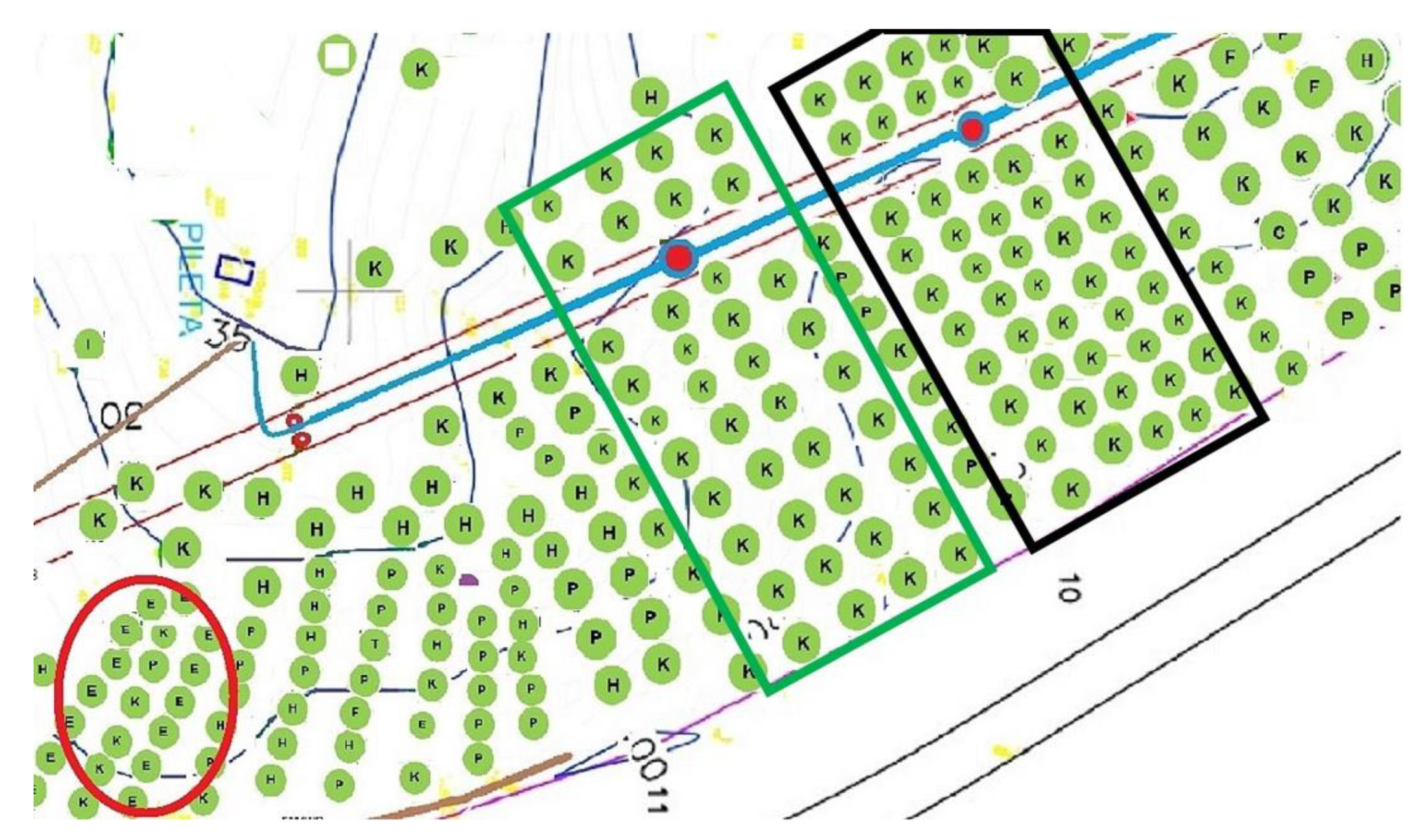



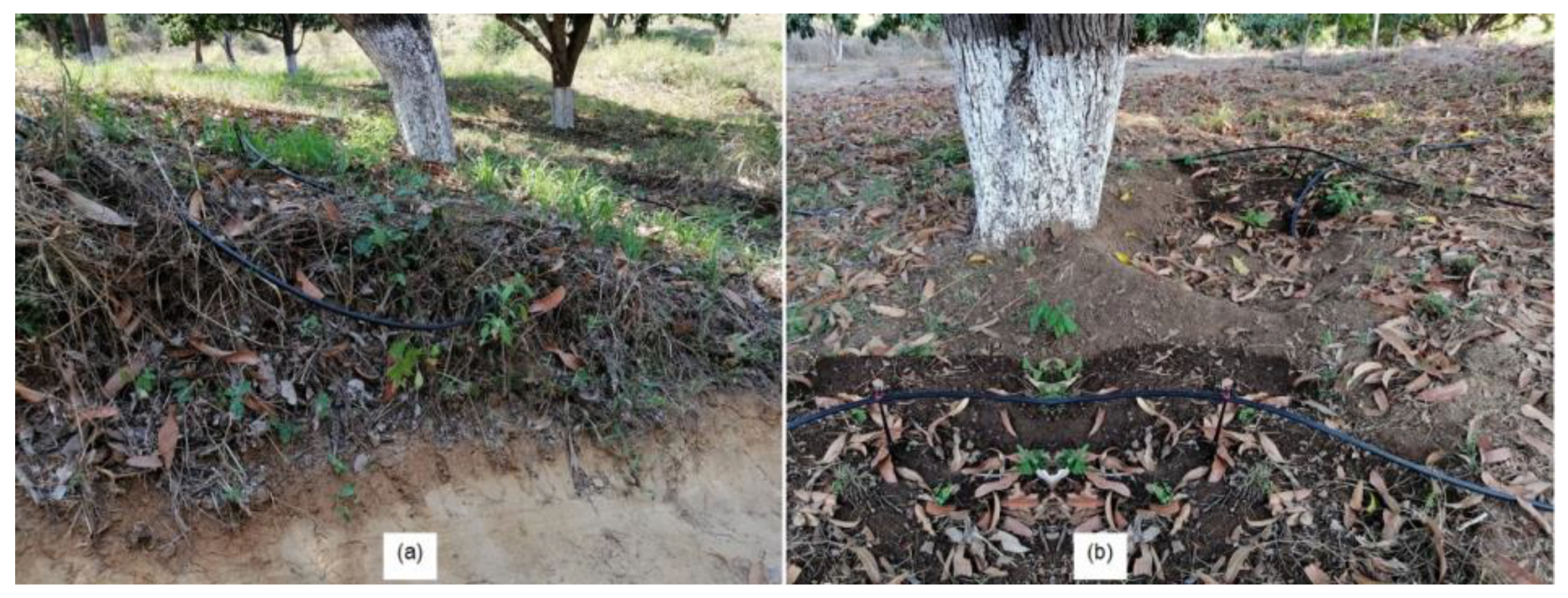
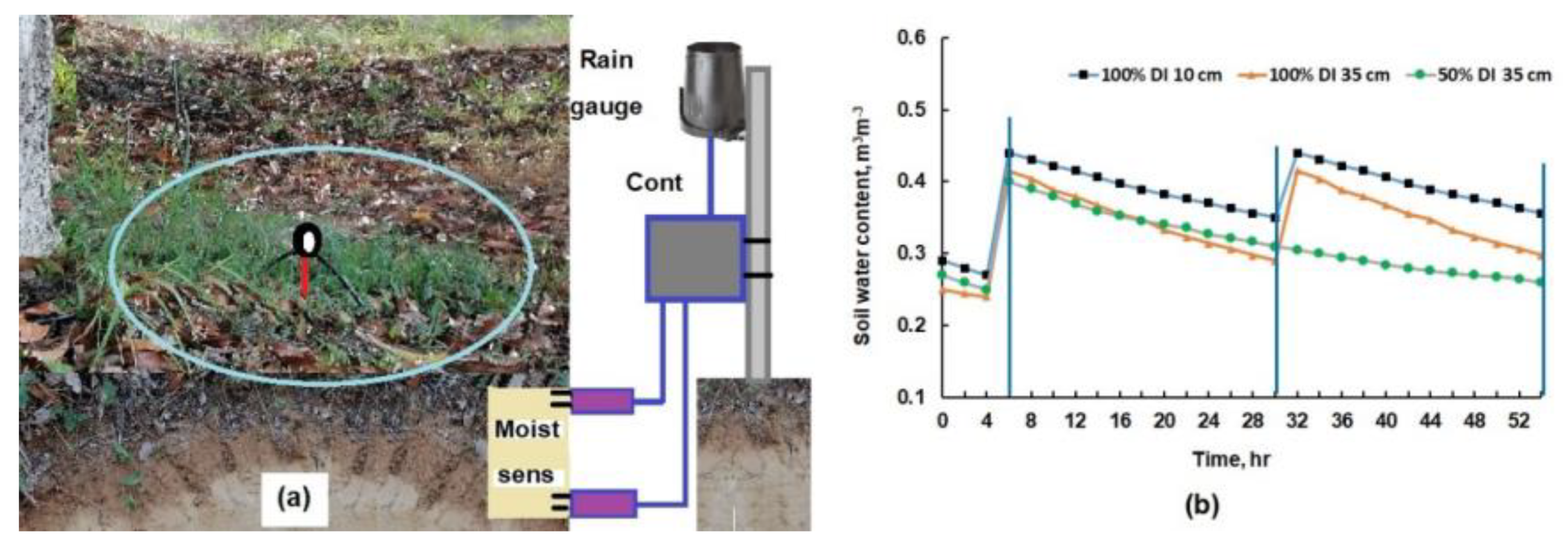


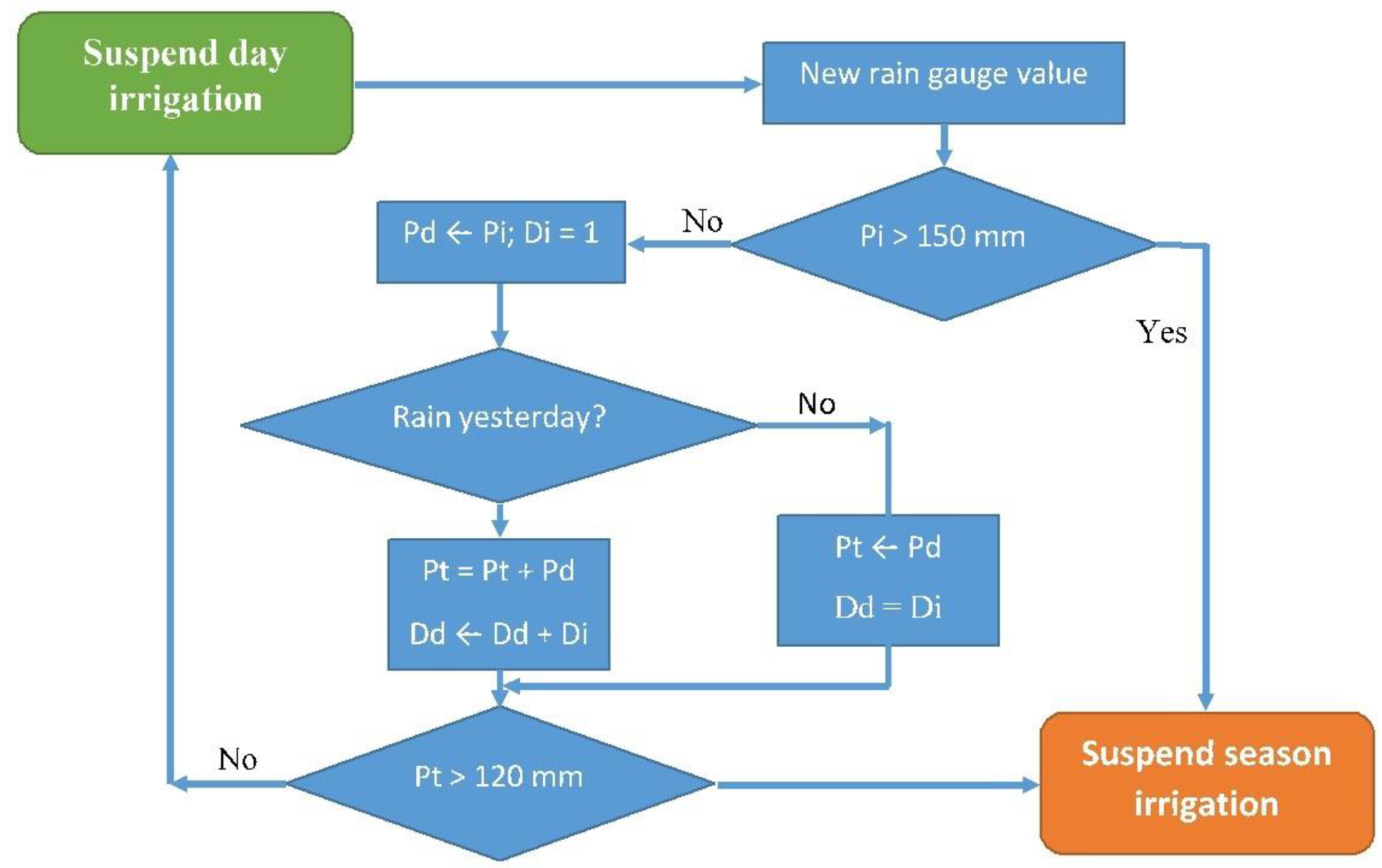
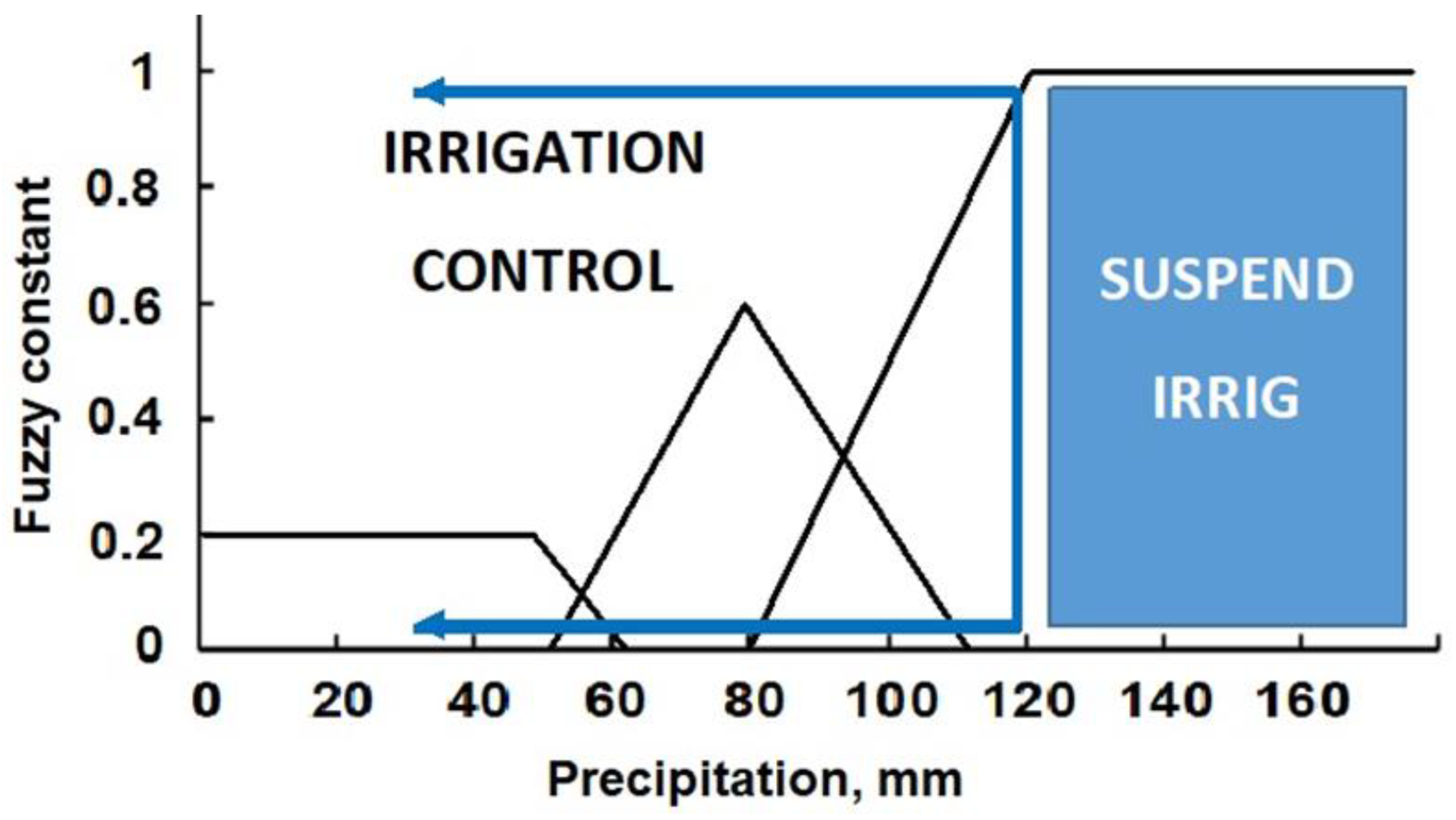
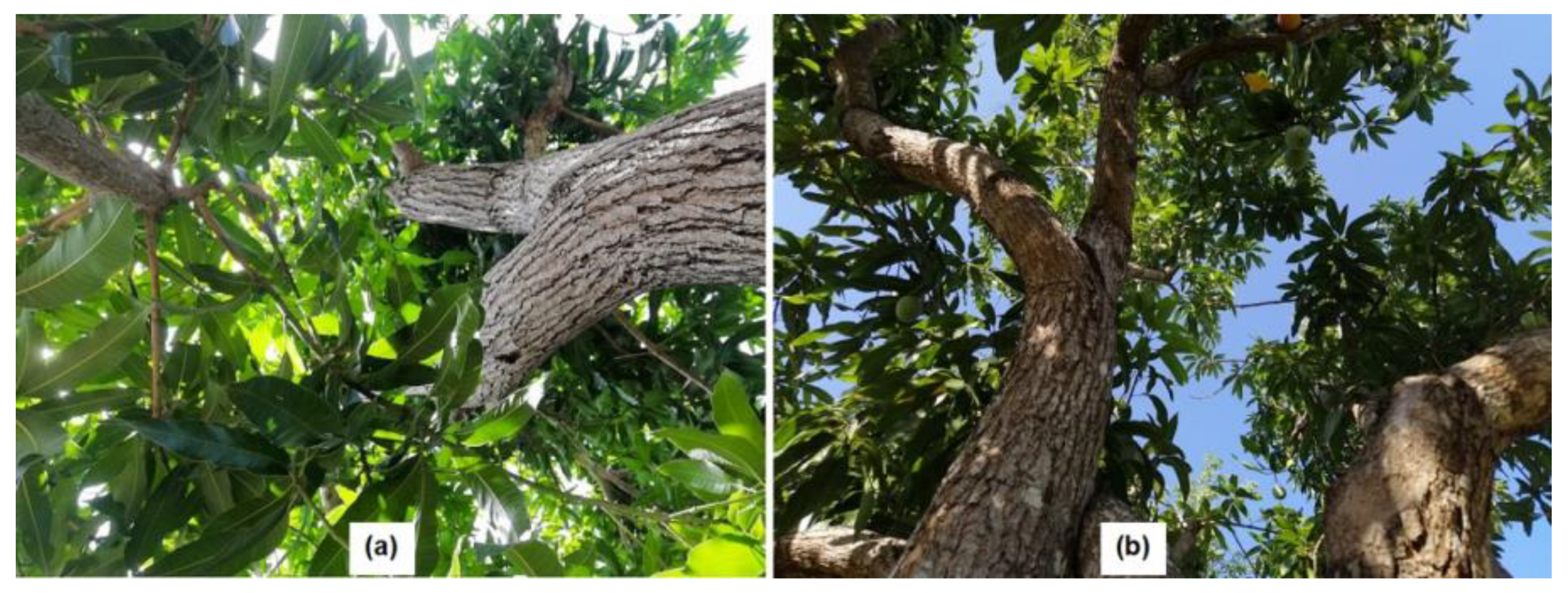

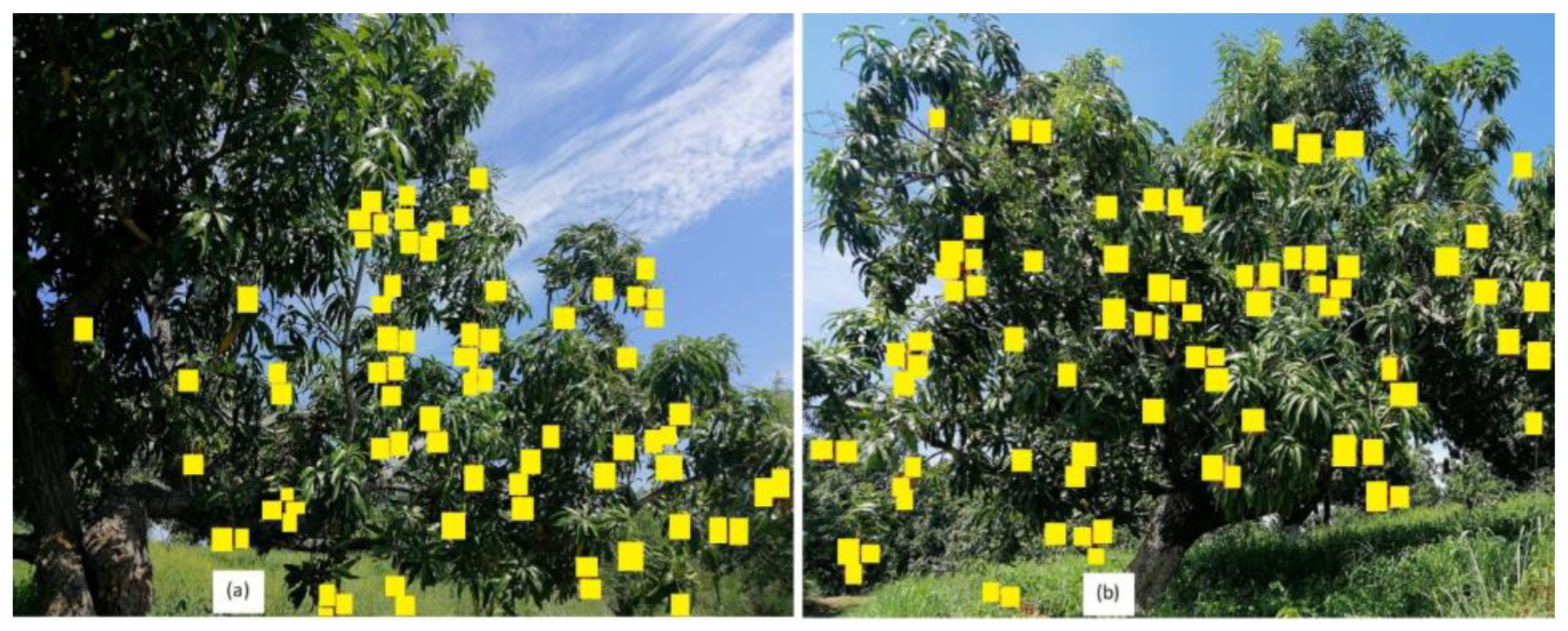
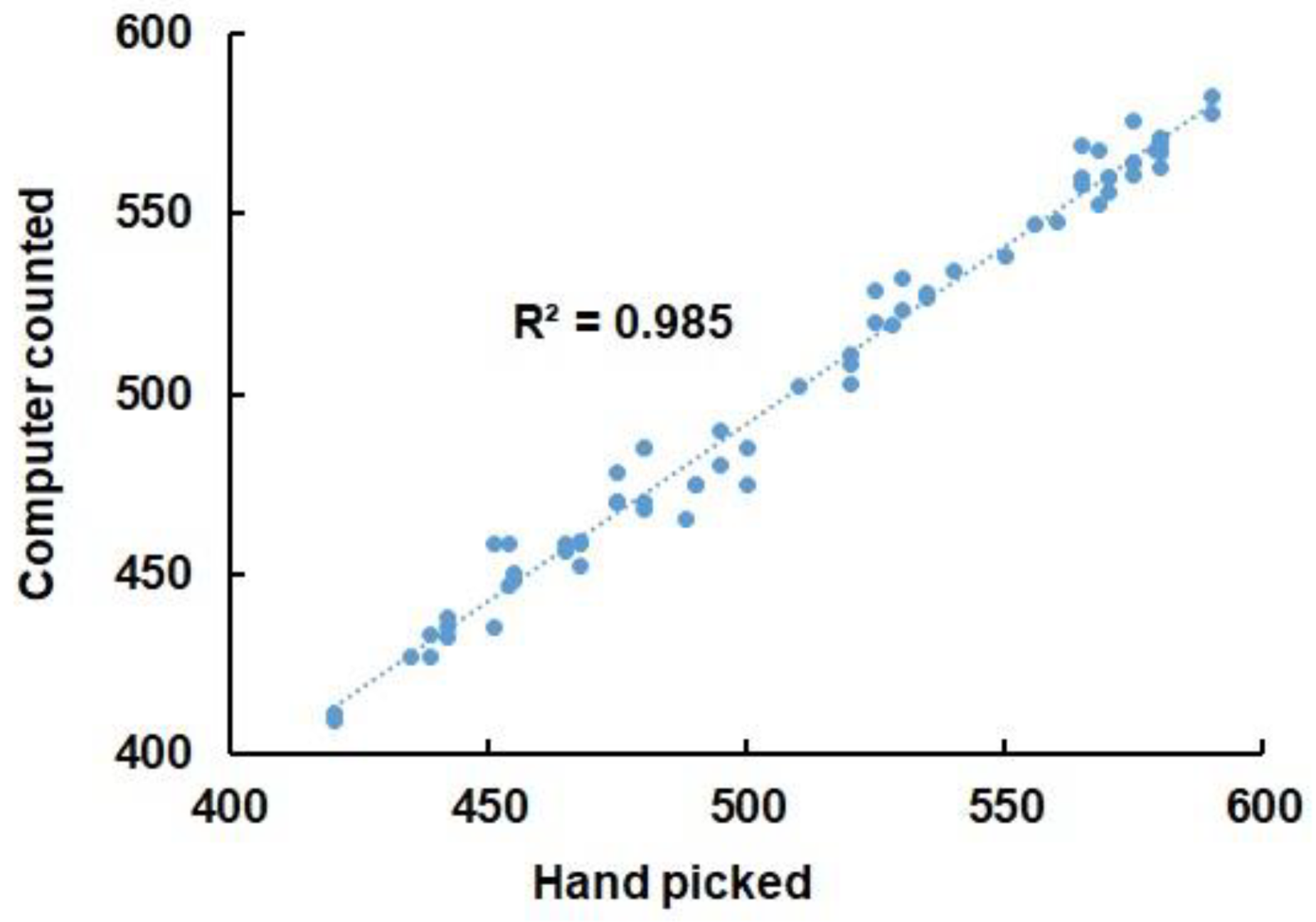


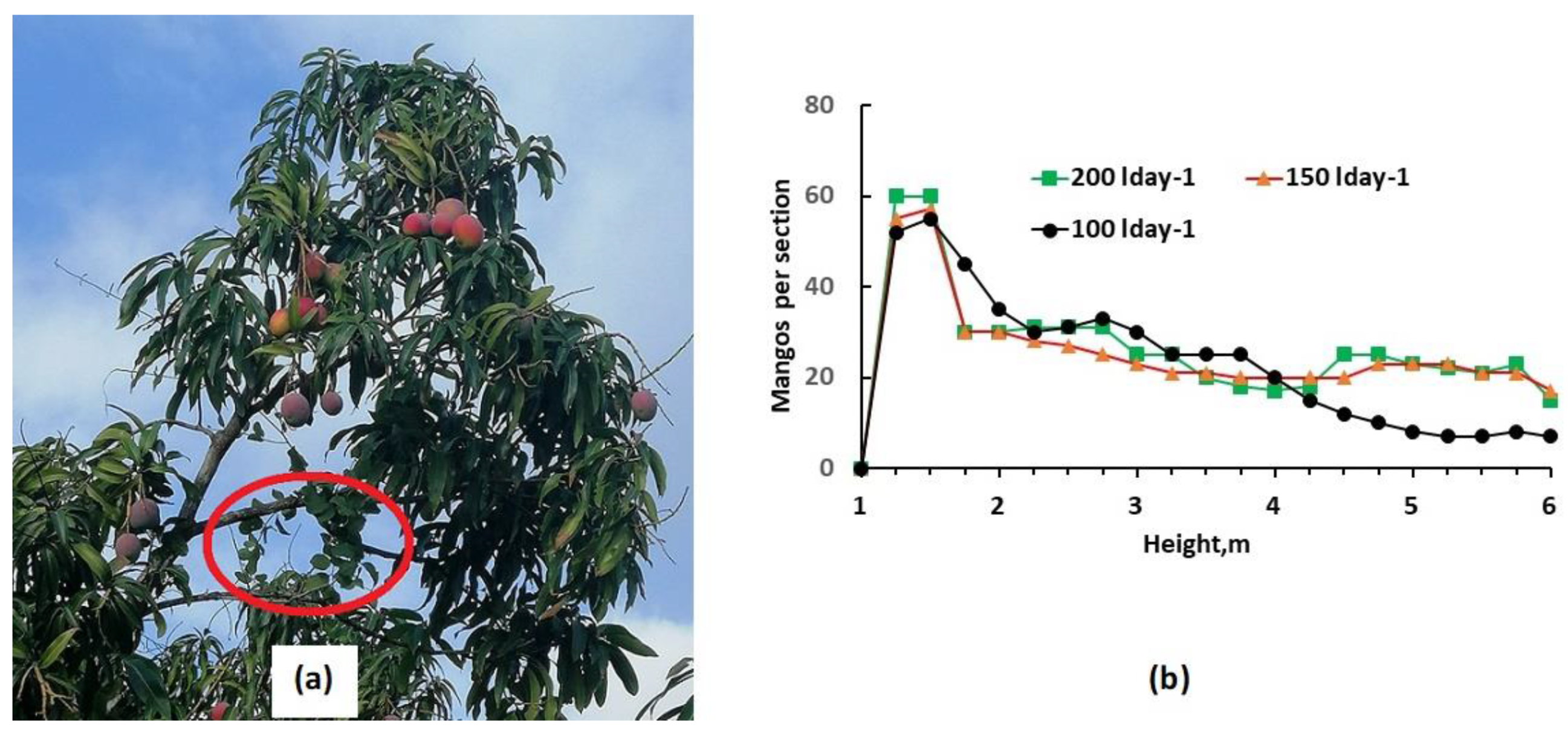
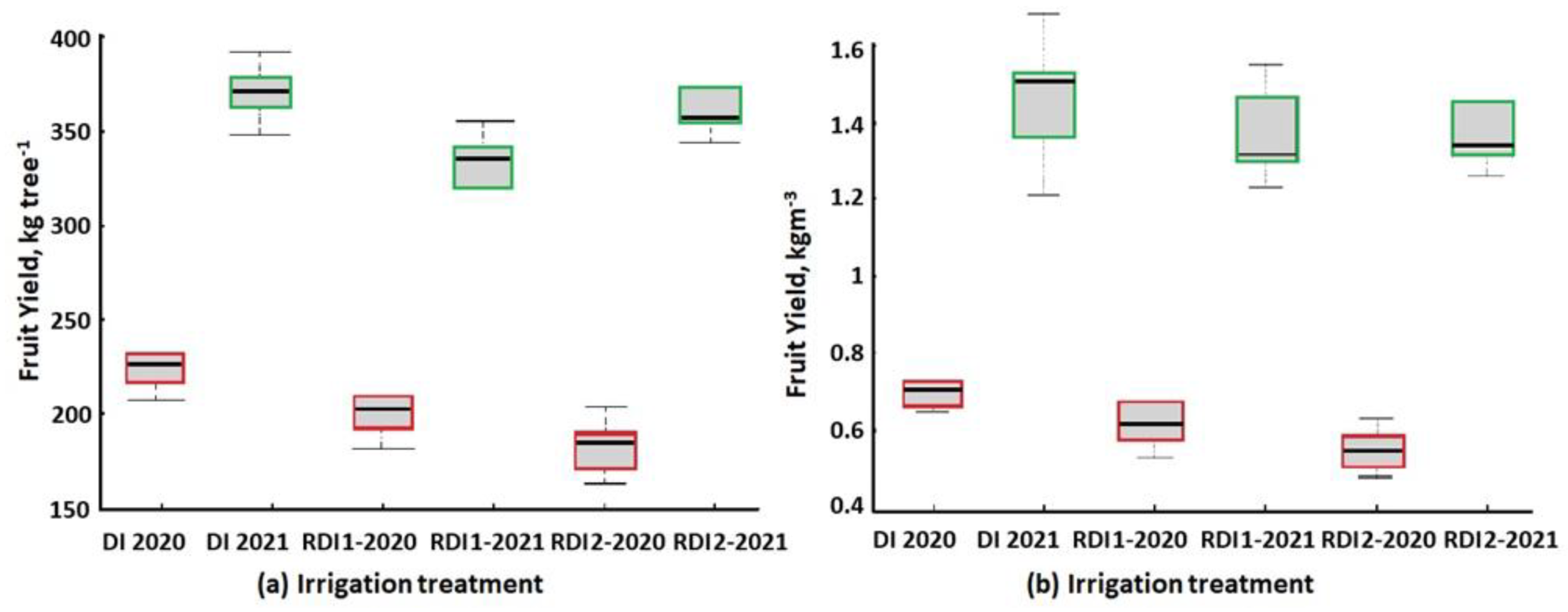

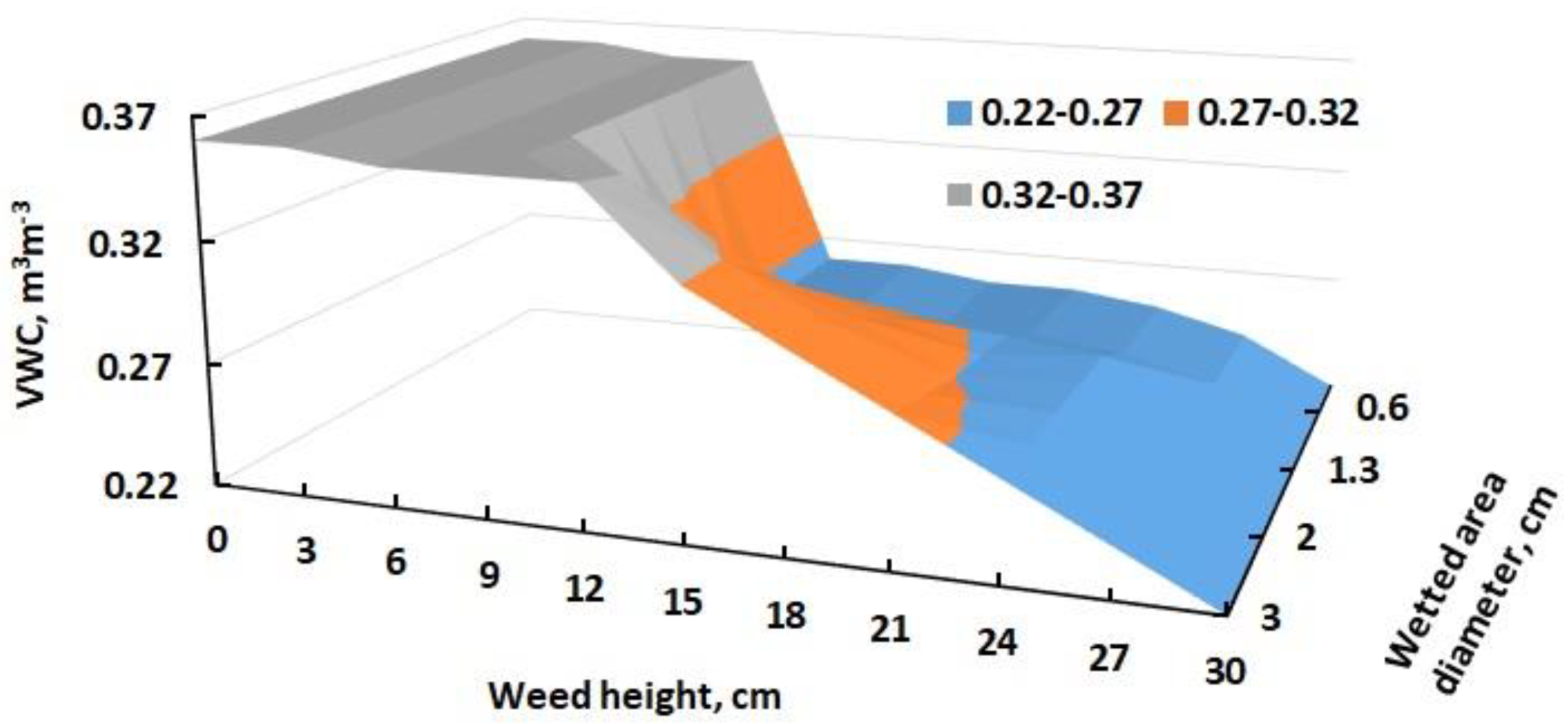
| Event | Rainfall | Weed at Day 10 | Weed at Day 17 | Action | |||
|---|---|---|---|---|---|---|---|
| Mm | Days | cov, % | Height, cm | cov, % | Height, cm | ||
| 1 | 75 | 1 | 10 | 5 | 25 | 10 | D |
| 2 | 80 | 2 | 20 | 7 | 25 | 12 | D |
| 3 | 80 | 3 | 25 | 7 | 25 | 12 | D |
| 4 | 100 | 1 | 18 | 8 | 28 | 15 | D |
| 5 | 100 | 2 | 25 | 8 | 32 | 15 | D |
| 6 | 100 | 3 | 38 | 8 | 35 | 18 | D |
| 7 | 120 | 2 | 40 | 10 | 60 | 25 | S |
| 8 | 150 | 1 | 25 | 8 | 60 | 30 | S |
| 9 | 150 | 2 | 41 | 10 | 70 | 30 | S |
| 10 | 150 | 3 | 48 | 10 | 80 | 30 | S |
| Objective | Study Carried out | Sensors & Equipment | Comments |
|---|---|---|---|
| Pruning | Effect of fruit size and yield after pruning | Chainsaw, laser meter, mango counter | Obtain ground cover and radiation, calculate real canopy volume and calculate fruit size and yield. |
| Irrigation | Effect of irrigation treatments on yield and fruit size | Laser meter, mango counter | Analysis of irrigation treatments on yield, fruit size. |
| Fuzzy controller | Fuzzy controller impact on fruit size and yield | Controller, laser meter, mango counter | Use of fuzzy algorithm together with different irrigation treatments |
| WUE | Water-use efficiency under each irrigation treatment and with fuzzy controller | Controller | Water-use efficiency caused by pruning and controller |
| HD-Mature | High-density and mature fruit yield | Comparison of water use and yield between high-density and mature trees per hectare |
| 2020 | 2021 | |||||
|---|---|---|---|---|---|---|
| 100% | 75% | 50% | 100% | 75% | 50% | |
| Tree height, m | 2.46 | 2.43 | 2.43 | 2.73 | 2.76 | 2.76 |
| Canopy diameter, m | 2.1 | 1.99 | 2.19 | 2.35 | 2.33 | 2.35 |
| Number branches | 3.4 | 3.9 | 4.2 | 3.4 | 4 | 4.2 |
| Canopy volume m3 | 3.46 | 3.1 | 3.69 | 4.8 | 5.71 | 4.83 |
| Leaf number | 760 | 767 | 776 | 862 | 767 | 766 |
| trunk diameter, cm | 8.73 | 8.58 | 8.71 | 9.7 | 9.73 | 9.72 |
| 2020 | 2021 | |||||
|---|---|---|---|---|---|---|
| 100% | 75% | 50% | 100% | 75% | 50% | |
| Tree height, m | 8.1 | 8.11 | 8.1 | 6.8 | 6.85 | 6.75 |
| Canopy area, m2 | 78.5 | 78 | 78.5 | 63.58 | 63.6 | 63.58 |
| Number branches | 7.6 | 7.7 | 7.8 | 7.6 | 7.7 | 7.8 |
| Canopy volume m3 | 313.69 | 312.11 | 313.69 | 209.43 | 211.22 | 207.72 |
| trunk diameter, cm | 32.34 | 32.4 | 32.22 | 32.66 | 32.58 | 32.51 |
| Event | Tree Parameters | ||||||
|---|---|---|---|---|---|---|---|
| H, m | CEA, m2 | IAWL, m2 | CV, m3 | RCV, m3 | GCF% | Rad@1,% | |
| 2020M | 8.1 | 78.5 | 0 | 313.68 | 313.6 | 29 | 31.4 |
| 2020S | 6 | 63.58 | 20.1 | 181.9 | 161.8 | 41 | 65.2 |
| 2021M | 6.8 | 69.36 | 22.3 | 228.47 | 155 | 39 | 61.7 |
| Irrigation Treatment | Irrig, m3/Tree | Canopy Volume, m3 | Fruit Yield, kg/Tree | Fruit/ Tree | Fruit Weight, g | Fruit Yield kg/m3 | WUE Kg/m−3 |
|---|---|---|---|---|---|---|---|
| Irrigation | 2020 | ||||||
| DI(100% ET) | 6 | 3.46a | 37.6a | 52.9a | 710.9a | 10.9a | 6.3c |
| RDI1 (75%ET) | 4.5 | 3.1a | 33.66b | 46.4b | 725.3a | 10.9a | 7.5b |
| RDI2 (50%ET) | 3 | 3.69a | 28.16c | 37.9c | 742.5a | 7.6b | 9.4a |
| Irrigation | 2021 | pruned | trees | ||||
| DI(100% ET) | 6 | 3.52a | 39.62a | 55.8a | 710.2c | 11.3a | 6.6c |
| RDI1 (75%ET) | 4.5 | 3.56a | 36.47b | 50b | 729.4b | 10.26b | 8.1b |
| RDI2 (50%ET) | 3 | 3.44a | 34.96c | 46.4c | 753.6a | 11.17b | 11.7c |
| ANOVA | |||||||
| Interaction | 2020 | * | * | * | * | * | |
| Interaction | 2021 | * | * | * | * | * | * |
| Interaction | * | * | * | * | * |
| Irrigation Treatment | Irrig, m3/Tree | Canopy Volume, m3 | Fruit Yield, kg/Tree | Fruit/ tree | Fruit Weight, g | Fruit Yield kg/m3 | WUE Kg/m−3 |
|---|---|---|---|---|---|---|---|
| Irrigation | 2020 | ||||||
| DI(100% ET) | 19.92 | 314.7c | 226.46a | 488a | 464a | 0.72a | 11.4c |
| RDI1 (75%ET) | 14.98 | 319.5b | 203.24b | 467.8b | 434.2b | 0.64b | 13.6b |
| RDI2 (50%ET) | 9.98 | 329a | 184.85c | 442c | 418.2b | 0.56c | 18.5a |
| Irrigation | 2021 | pruned | trees | ||||
| DI(100% ET) | 19.92 | 246a | 361.53a | 579a | 624.4a | 1.47a | 18.15c |
| RDI1 (75%ET) | 14.98 | 250.8a | 352.74b | 560.8b | 629a | 1.41ab | 23.55b |
| RDI2 (50%ET) | 9.99 | 248.6a | 335.81c | 528c | 636a | 1.36b | 33.62a |
| ANOVA | |||||||
| Interaction | 2020 | * | * | * | * | * | |
| Interaction | 2021 | * | * | * | * | * | * |
| Interaction | * | * | * | * | * |
| Irrigation Treatment | Irrig, m3/Tree | Canopy Volume, m3 | Fruit Yield, kg/Tree | WUE Kg/m−3 |
|---|---|---|---|---|
| Irrigation | 2021 | |||
| DI(100% ET) | 19.92 | 246a | 361.53a | 18.15c |
| RDI1 (75%ET) | 14.98 | 250.8a | 352.74b | 23.55b |
| RDI2 (50%ET) | 9.99 | 248.6a | 335.81c | 33.62a |
| Irrigation | 2022 | |||
| DI(100% ET) | 19.92 | 263.2a | 372.79a | 18.71c |
| RDI1 (75%ET) | 14.98 | 264.7a | 360.23b | 24.05b |
| RDI2 (50%ET) | 9.99 | 253.3a | 350.28c | 35.06a |
| Irrigation Treatment | Irrig, m3/Tree | Canopy Volume, m3 | Fruit Yield, kg/Tree | Fruit/ Tree | Fruit Weight, g | Fruit Yield kg/m3 | WUE Kg/m−3 |
|---|---|---|---|---|---|---|---|
| Irrigation | 2020 | ||||||
| DI(100% ET) | 6 | 3.46a | 37.6a | 52.9a | 710.9a | 10.9a | 6.3c |
| RDI1 (75%ET) | 4.5 | 3.1a | 33.66b | 46.4b | 725.3a | 10.9a | 7.5b |
| RDI2 (50%ET) | 3 | 3.69a | 28.16c | 37.9c | 742.5a | 7.6b | 9.4a |
| Irrigation | 2021 | pruned | trees | + fuzzy | control | ||
| DI(100% ET) | 1.5 | 3.1b | 44.83a | 57.8a | 775.6b | 14.46a | 29.89c |
| RDI1 (75%ET) | 1.13 | 3.23a | 39.01b | 50.4b | 774b | 12.08b | 34.52b |
| RDI2 (50%ET) | 0.75 | 3.22a | 33.14c | 42c | 789a | 10.29c | 44.18a |
| ANOVA | |||||||
| Interaction | 2020 | * | * | * | * | * | |
| Interaction | 2021 | * | * | * | * | * | * |
| Interaction | * | * | * | * | * |
| Irrigation Treatment | Irrig, m3/Tree | Canopy Volume, m3 | Fruit Yield, kg/Tree | Fruit/ Tree | Fruit Weight, g | Fruit Yield kg/m3 | WUE Kg/m−3 |
|---|---|---|---|---|---|---|---|
| Irrigation | 2020 | ||||||
| DI(100% ET) | 19.92 | 314.7c | 226.46a | 488a | 464a | 0.72a | 11.4c |
| RDI1 (75%ET) | 14.98 | 319.5b | 203.24b | 467.8b | 434.2b | 0.64b | 13.6b |
| RDI2 (50%ET) | 9.98 | 329a | 184.85c | 442c | 418.2b | 0.56c | 18.5a |
| Irrigation | 2021 | pruned | trees | + fuzzy | control | ||
| DI(100% ET) | 7.56 | 257.8b | 361.64a | 579a | 624.4a | 1.4a | 47.84c |
| RDI1 (75%ET) | 5.7 | 269.8a | 363.91a | 575a | 629a | 1.35ab | 63.84b |
| RDI2 (50%ET) | 3.8 | 254.2b | 332.85b | 525b | 636a | 1.31b | 87.59a |
| ANOVA | |||||||
| Interaction | 2020 | * | * | * | * | * | |
| Interaction | 2021 | * | * | * | * | * | |
| Interaction | * | * | * | * | * |
| Irrigation Treatment | Water Supplied m3 ha−1 | Trees ha−1 | Yield kg ha−1 | WUE kg m−3 |
|---|---|---|---|---|
| 100% HD | 1500 | 250 | 9905 | 6.6 |
| 75% HD | 1125 | 250 | 9117 | 8.1 |
| 50% HD | 750 | 250 | 8740 | 11.65 |
| 100% MATURE | 1992 | 100 | 36,153 | 18.2 |
| 75% MATURE | 1498 | 100 | 35,274 | 23.6 |
| 50% MATURE | 996 | 100 | 33,581 | 33.6 |
Publisher’s Note: MDPI stays neutral with regard to jurisdictional claims in published maps and institutional affiliations. |
© 2022 by the authors. Licensee MDPI, Basel, Switzerland. This article is an open access article distributed under the terms and conditions of the Creative Commons Attribution (CC BY) license (https://creativecommons.org/licenses/by/4.0/).
Share and Cite
Hahn, F.; Valle, S.; Navarro-Gómez, C. Pruning and Water Saving Management Effects on Mango High-Density and Mature Orchards. Agronomy 2022, 12, 2623. https://doi.org/10.3390/agronomy12112623
Hahn F, Valle S, Navarro-Gómez C. Pruning and Water Saving Management Effects on Mango High-Density and Mature Orchards. Agronomy. 2022; 12(11):2623. https://doi.org/10.3390/agronomy12112623
Chicago/Turabian StyleHahn, Federico, Salvador Valle, and Carmen Navarro-Gómez. 2022. "Pruning and Water Saving Management Effects on Mango High-Density and Mature Orchards" Agronomy 12, no. 11: 2623. https://doi.org/10.3390/agronomy12112623
APA StyleHahn, F., Valle, S., & Navarro-Gómez, C. (2022). Pruning and Water Saving Management Effects on Mango High-Density and Mature Orchards. Agronomy, 12(11), 2623. https://doi.org/10.3390/agronomy12112623






